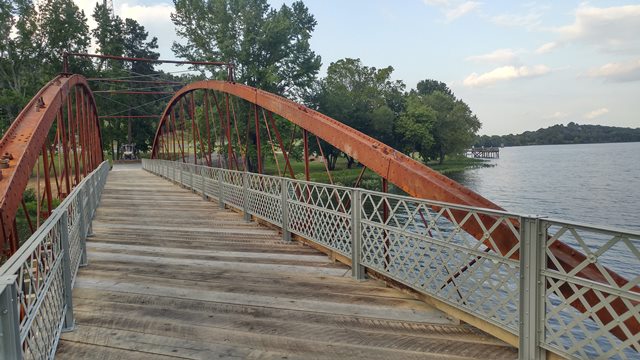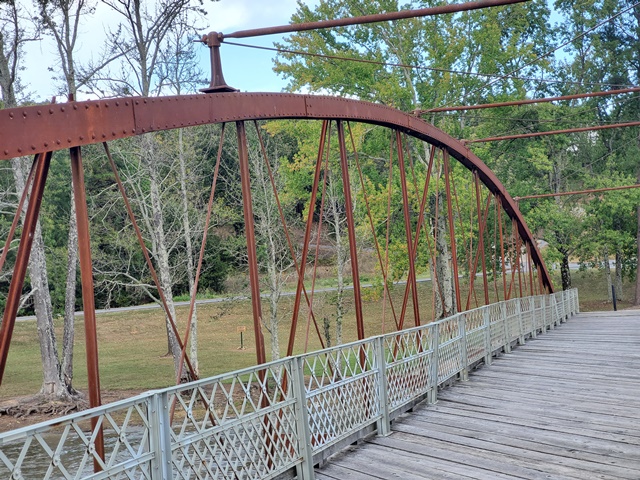We Recommend:
Bach Steel - Experts at historic truss bridge restoration.
BridgeHunter.com Phase 1 is released to the public! - Visit Now
Springfield Bridge
Beaverfork Park Bridge, Springfield-Des Arc Bridge

Primary Photographer(s): Nels Raynor (Bach Steel) and Nathan Holth
Bridge Documented: November 2016 - August, 2017 and September 30, 2021
Conway: Faulkner County, Arkansas: United States
Metal 16 Panel Threaded Rod-Nut Connected Bowstring Through Truss, Fixed and Approach Spans: Wood Stringer (Multi-Beam), Fixed
1874 By Builder/Contractor: King Bridge Company of Cleveland, Ohio
2017
146.0 Feet (44.5 Meters)
186.0 Feet (56.7 Meters)
12 Feet (3.66 Meters)
1 Main Span(s) and 2 Approach Span(s)
Not Applicable

View Information About HSR Ratings
Bridge Documentation
View Historic American Engineering Record (HAER) Documentation For This Bridge
HAER Data Pages, PDF - HAER Drawings, PDF
View The National Register of Historic Places Nomination Form For This Bridge
History and Significance of Bridge
The Springfield Bridge is the most historically significant metal bridge in Arkansas, and it is the oldest known surviving bridge of any type in the state, and one of only two surviving cast and wrought iron bowstring bridges in Arkansas. The bridge is an early, rare, and complete example of the patented bowstring design of the King Iron Bridge Company of Cleveland, Ohio. This particular bridge has an uncommon history. It was fabricated in a small branch shop of the King Bridge Company called the King Bridge Manufactory & Iron Works of Iola, Kansas. However, local politics prevented the bridge from being erected until 1874. This is an important item of note because bridge design was in a period of experimentation and changed almost yearly during the 1870s. Knowing that this bridge's fabrication (and thus its design) actually dates to 1871 helps explain why some of this bridge's details are unlike most other King Bridge Company bowstring bridges. Most surviving King bowstrings are newer than 1871. Therefore, this bridge is one of the oldest, and has some uncommon design details compared to other examples.
There are a few specific details associated with the older design of bowstring that are found in the Springfield Bridge and are worth noting. The bridge includes simple eyebars for the lower chord with large, heavy eyes that require the bottom chord to spread out at the eyebar pin splices. Newer bowstrings by the King Bridge Company had a knife-like design of eyebar head where the two eyes slid together and provided a uniform width of the lower chord throughout the length of the bridge, even at splice points. Vertical members on the bridge have no lattice connecting them to the outriggers as would be found on later bridges by King. The bridge also has an unusual lower lateral bracing system where the laterals are double-intersecting, meaning they overlap each other in each panel.
This bridge served traffic until a new bridge was built on nearby new alignment in 1991, a service life of 117 years.

Relocation and Restoration
After being abandoned for 25 years, the Springfield Bridge's trusses had begun to lean at an alarming angle, while abutments and deck deteriorated and tall trees around the bridge threatened to fall on the bridge. It was clear the bridge would eventually collapse if nothing was done. A multi-year effort was made to raise awareness that included local efforts by Kenneth C. Barnes, Professor of History at University of Central Arkansas, and national support from Julie Bowers, executive director of Workin' Bridges, as well as a successful nomination by HistoricBridges.org to get the Springfield Bridge included in Preserve Arkansas' Most Endangered Places list. The effort was successful and gained the support of the Faulkner county judge and Conway city mayor. The decision was made to have the bridge relocated and restored in Beaverfork Park in the City of Conway, less then 10 miles from the bridge's original location.
The relocation involved removal with crane to set the bridge on the ground, disassembly of all bridge parts, blasting to remove paint, restoration, reassembly in the new location, and a crane pick to place the bridge over the lake. The disassembly revealed some unusual secrets about this bridge. When the upper chord splices were taken apart, this revealed fabricator punch marks used to place rivet holes, but some of the channels also had punch marks that spelled out numbers and characters. Perhaps these were used as a sort of numbering system. In any case, these details had not been visible since 1874, and they are again hidden within the splices today. Another unusual encounter during disassembly was severe cracking and tears in a couple areas of the upper chord. These appear to have been from the original 1874 erection of the bridge. Perhaps the bridge even collapsed during erection. In any case, these defects appear to have been repaired in the field in a somewhat crude manner. Despite this, the bridge remained standing for over a century! Nevertheless, during the 2016-2017 restoration, these portions of the bridge were restored in a more complete manner returning the bridge to its original design strength.
The deteriorated paint on the bridge was blasted off in a paint yard after disassembly. In its new location, this cast and wrought iron bowstring truss is unpainted. In a location where it will not see heavy use of corrosive winter deicing salts, the uniquely rust-resistant properties (comparable to modern weathering steel) of 19th Century cast and wrought iron (as compared to modern mild steel) simply does not need to be painted, saving on both project costs, and future maintenance costs.
In a nod to 19th and early 20th Century bridge design, the new piers for the bridge in Beaverfork Park were designed to simulate the appearance of riveted steel caissons (sometimes called Lally Columns) which were common during this period. Additionally, stone from the original abutments was salvaged and transported to Beaverfork Park and placed around the concrete abutments as a reminder of the bridge's original substructure.
One unique feature of this bridge's restoration is the new railing on the bridge. In its rural location, this bridge originally was not constructed with any known railing. However to reopen the bridge for pedestrian traffic, a railing was required to address the need for pedestrian safety. Rather than select a modern railing that would have either failed to compliment the historic appearance of the bridge, or worse might have been downright ugly (cyclone fence, etc), a decision was made to have Bach Steel (the contractor responsible for the relocation and restoration of the project) design a railing that met current-day code while offering a historic and visually attractive design. Bach Steel designed a railing that closely replicates a style of railing used by a number of bridge companies in the 19th century including the King Bridge Company itself, as well as other noted companies like the Phoenix Bridge Company of Phoenixville, Pennsylvania. The design is more aesthetically pleasing than traditional lattice railing because it has an upper section of double-lacing style lattice, and a lower section of a more dense lattice mesh. HistoricBridges.org played a small role in finding suitable railing design by providing photos, drawings and historic postcards of period bridge railings. The Bach Steel design looks very similar to this railing style as used by 19th century bridge companies but meets codes for bridges carrying non-motorized traffic in the 21st century. The King Bridge Company called the style its "Richmond" railing standard as shown below on a page from a company book of standard drawings. The railing on the Springfield Bridge was fabricated using genuine hot-driven rivets by Bach Steel.

In its new location the bridge enjoys higher visibility, and a purpose to more conveniently connect two areas of the park by providing a path over a portion of the Beaverfork Lake. The bridge carries non-motorized traffic only.
Some of the organizations and companies involved with the Springfield Bridge Relocation and Restoration Project included:
Bach Steel (Holt, Michigan) - Bridge relocation and restoration including: Disassembly, restoration, reassembly.
Schiffer Group Engineering (Traverse City, Michigan) - Design engineering for relocation and restoration.
Workin' Bridges - Fundraising, administration, project organizing, public awareness.
Dick Mooney Crane Rental (Benton, Arkansas) - Crane services.
The Sand Man (Little Rock, Arkansas) - Paint/Blasting Services.
Faulkner County - Original owner of bridge.
City of Conway - New owner of bridge.
This bridge is tagged with the following special condition(s): Unorganized Photos
![]()
Photo Galleries and Videos: Springfield Bridge
Bridge Photo-Documentation
Original / Full Size PhotosA collection of overview and detail photos. This gallery offers photos in the highest available resolution and file size in a touch-friendly popup viewer.
Alternatively, Browse Without Using Viewer
![]()
Bridge Photo-Documentation
Mobile Optimized PhotosA collection of overview and detail photos. This gallery features data-friendly, fast-loading photos in a touch-friendly popup viewer.
Alternatively, Browse Without Using Viewer
![]()
Additional Unorganized Photos
Original / Full Size PhotosA supplemental collection of photos that are from additional visit(s) to the bridge and have not been organized or captioned. This gallery offers photos in the highest available resolution and file size in a touch-friendly popup viewer.
Alternatively, Browse Without Using Viewer
![]()
Additional Unorganized Photos
Mobile Optimized PhotosA supplemental collection of photos that are from additional visit(s) to the bridge and have not been organized or captioned. This gallery features data-friendly, fast-loading photos in a touch-friendly popup viewer.
Alternatively, Browse Without Using Viewer
![]()
Maps and Links: Springfield Bridge
This bridge was originally located over Caldron Creek here: 35.25270, -92.51271
Coordinates (Latitude, Longitude):
Search For Additional Bridge Listings:
Bridgehunter.com: View listed bridges within 0.5 miles (0.8 kilometers) of this bridge.
Bridgehunter.com: View listed bridges within 10 miles (16 kilometers) of this bridge.
Additional Maps:
Google Streetview (If Available)
GeoHack (Additional Links and Coordinates)
Apple Maps (Via DuckDuckGo Search)
Apple Maps (Apple devices only)
Android: Open Location In Your Map or GPS App
Flickr Gallery (Find Nearby Photos)
Wikimedia Commons (Find Nearby Photos)
Directions Via Sygic For Android
Directions Via Sygic For iOS and Android Dolphin Browser
USGS National Map (United States Only)
Historical USGS Topo Maps (United States Only)
Historic Aerials (United States Only)
CalTopo Maps (United States Only)


